8 Highest Rated Emergency Motorcycle Tire Repair Kits for 2021
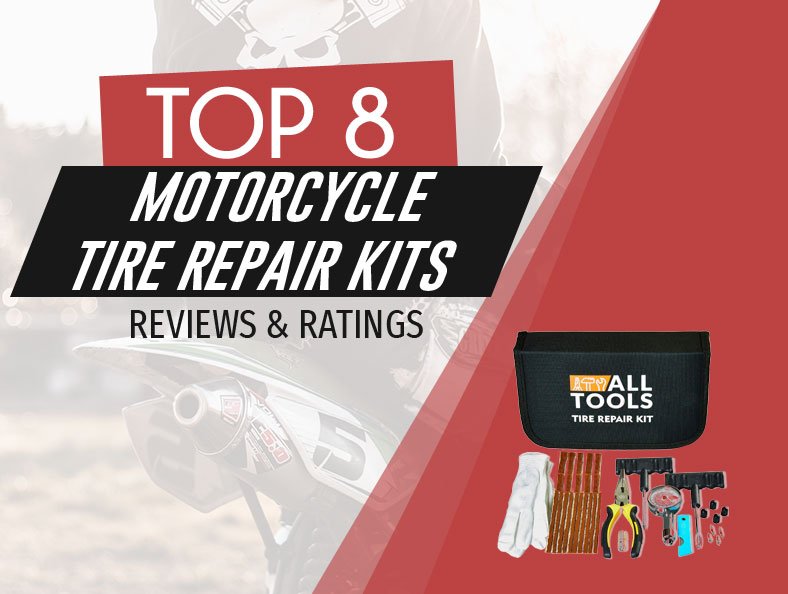
Road Racerz is proudly supported by our readers. Products purchased through links on our site may provide us a commission. Learn More
A tire puncture is something we’ve all dealt with. It’s an inconvenience that can also be quite dangerous if it happens on the road. Has it ever happened to you? How do you usually deal with it?
Most people choose to take their bikes to professionals, but that is often a costly solution. Plus, it’s inconvenient if you’re on a planned journey and far away from home.
Luckily, there’s another way to get out of this unfortunate situation. With a reliable motorcycle tire repair kit, you can handle the issue right then and there.
Take a few minutes to discover the best kits and their pros and cons. You’ll also find some useful info on how to choose one for your motorcycle.
Top 8 Motorcycle Tire Repair Kit Reviews
| PRODUCT | FEATURES | |
|---|---|---|
ALLTOOLS 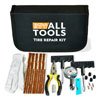 | ALLTOOLS Features: Heavy-duty brown strings, a mechanical tire pressure gauge, replacement valve cores, gloves, plastic caps, and four-way too simultaneously listening to music, FM radio, or GPS Product Dimensions: 8.3 x 1.8 x 5 inches | Check Price |
Boulder Tools 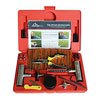 | Boulder Tools Features: Brown strings, quality pliers, two hex keys, lubricant, four valve caps Product Dimensions: 12 x 2.2 x 8 inches | Check Price |
Tooluxe 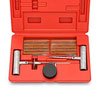 | Tooluxe Features: 30-pc 4inch string plugs for multiple repairs, 1-pc rasp tool, 1-pc insert tool, 2-pc hex keys and 1 sealing lubricant Product Dimensions: 12 x 8 x 2.5 inches | Check Price |
AUTOWN 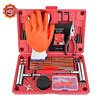 | AUTOWN Features: 75 pieces Product Dimensions: 11.8 x 7.7 x 2.4 inches | Check Price |
Stop & Go 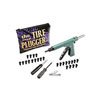 | Stop & Go Features: 25 mushroom-shaped rubber plugs, plug instetion tool, reamer too, retractable blade Product Dimensions: 9 x 1 x 6 inches | Check Price |
BETOOLL 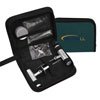 | BETOOLL Features: 1pc T-handle insert tool, 1pc T-handle spiral probe tool, 1pc “L” hex key, 1pc jar of lubricant, 15pcs self-vulcanization repair plugs , 2pcs tire value steams and 1pc 4-way valve stem tool Product Dimensions: 8 x 5 x 5 inches | Check Price |
Dynaplug 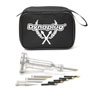 | Dynaplug Features: Aluminum Xtreme tool, (8) repair plugs, (3) insertion tubes, (1) air stopper, (1) clearing attachment and (1) pipe cleaner Product Dimensions: 6.7 x 4.7 x 2.7 inches | Check Price |
Safety Seal 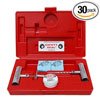 | Safety Seal Features: Thirty 4-inch strings, metal T-Handle insertion tool, extra insertion needle, metal T-Handle spiral probe, wrench and set screw, and a lube Product Dimensions: 12 x 9.4 x 2.5 inches | Check Price |
ALLTOOLS – Best Versatile
This is one of the most versatile kits that’s suitable for people who don’t have as much skill and experience. It includes instructions that are easy to follow if it’s your first time repairing a puncture.
The kit comes with heavy-duty brown strings that are often considered much stronger than the usual black strings. Also, it features a mechanical tire pressure gauge, replacement valve cores, gloves, plastic caps, and four-way tool.
Because all of the included parts and tools are engineered to be strong, the kit is suitable for plenty of different vehicles. It’s meant for tubeless tires of motorcycles, cars, tractors, ATVs, jeeps, trucks, and lawnmowers.
Alltools comes in a storage case that doesn’t take up much space, allowing you to carry it along at all times.
PROS
- Strong and durable
- Easy-to-follow instructions
- Storage case included
CONS
- For tubeless only
Boulder Tools – Best Heavy Duty
This premium kit is ideal for a wide range of different vehicles. It comes with brown strings and several other tools, allowing you to repair a flat tire regardless of where you are.
It’s meant for cars, ATVs, motorcycles, lawnmowers, tractors, dirt bikes, jeeps, trailers, RVs, and trucks. It comes with thirty superior brown plugs, which should be more than enough for all your needs.
Another thing worth mentioning is that this one comes with quality pliers, two hex keys, lubricant, four valve caps, and everything else you need to repair a tire. The box contains a total of 56 pieces.
Also, the kit comes with photo instructions, which is especially useful if it’s your first time doing something like this.
PROS
- 56 quality pieces
- Ergonomically designed tools
- Heavy-duty brown strings included
CONS
- Only one size of the plug and plug tool
Tooluxe – Best Universal
If you have several vehicles, you might want to consider this kit as one of the universal options. It’s meant for tubeless tires, but you don’t have to remove it from the rim to repair the puncture.
This one is packed with several useful devices, such as a spiral rasp made of hardened steel and an insert needle. The sandblasted finish is there for some added durability.
On top of that, the T-handle is more comfortable and easy to use at all times. It also gives you a higher turning power.
The tools come in a storage case that’s specifically designed for roadside emergencies.
The kit includes thirty 4’’ string plugs, one rasp tool, two hex keys, an insert tool, and a sealing lubricant.
PROS
- For different vehicles
- Durable and compact case
- Suitable for all kinds of vehicles
CONS
- For tubeless only
AUTOWN – Best Quality
Autown repair kit is a high-quality product made of steel. The tools included are designed to help you repair even the toughest tires.
This set is quite durable and has a long shelf life. In other words, you can carry it around for a long time, even if you’ve never used it.
It features 75 pieces for you to repair any tire on your motorcycle, car, ATV, lawnmower, tractor, jeep, or RV. Its ergonomically designed T-handle tools make it easier and more comfortable to fix different types.
The case itself is built to withstand rough and frequent usage. While the set comes with plenty of tools, you also get some lubricant and water-resistant gloves.
A very detailed user manual is also included.
PROS
- Durable
- Gloves included
- For all tires
CONS
- Some people didn’t receive the booklet
Stop & Go – Best for Emergency Situations
Having a puncture in the middle of the road is by far among the worst possible situations. However, this kit can help you quickly fix the problem and continue on your trip.
The set includes 25 mushroom-shaped rubber plugs, so it’s small enough for you to carry it at all times. You also get a spring-loaded gun that drives the plug into the puncture. The shaft will expand under pressure, filling the hole.
Since it’s shaped like a mushroom, the plug doesn’t allow any air to escape, allowing you to continue your trip.
The entire kit comes in a handy yet durable pouch that won’t take up much space.
It weighs only 14oz, so you won’t even notice it’s there most of the time.
PROS
- Lightweight and compact
- Ideal for emergencies
- For most vehicles
CONS
- Plugs are too soft class A motor home tires
BETOOLL – Best Plug & Go
This is another small kit that you can carry around with you at all times. It includes 22 pieces and is suitable for motorcycles, cars, ATVs, jeeps, trucks, tractors, RVs, and many more vehicles.
It comes with a T-Handle insert tool, a hex key, jar of lubricant, a T-Handle spiral probe, two tire valve steams, a 4-way valve stem device, and 15 pieces of repair plugs.
The repair plugs are self-vulcanizing and easy to insert. On top of that, the T-Handle allows you higher turning power and enhanced comfort.
Keep in mind that it’s meant for tubeless tires only, so it’s not recommended you use it on sidewall blowouts or tube tires.
Everything is neatly organized in a compact carry bag made of thick, durable materials.
PROS
- Easy to use
- Comes in a compact bag
- Ideal for emergencies
CONS
- No instructions included
Dynaplug – Best for Punctures
This handy pack is one of the best choices for punctures regardless of whether you’re at home or on the road. It comes in a zippered nylon pouch that’s compact and easy to carry around.
Storage slots are machined in the body, allowing you to store all the insertion tubes and accessories. The tools are designed for tubeless tires and require no glue. You also don’t have to remove it to fix the puncture.
The set is ideal for cars, motorcycles, trucks, scooters, motor homes, campers, tractors, RVs, and many more vehicles. It includes an aluminum Xtreme tool, eight repair plugs, three insertion tools, an air stopper, clearing attachment, and a pipe cleaner.
Because it’s so compact and lightweight, the case and all the contents are meant for on-the-go use.
PROS
- Perfect for on-the-road punctures
- Easy to use
- Comes in a handy pouch
CONS
- The plugs are relatively small
Safety Seal – Best Easy Storage
If you need a repair kit that’s easy to store, you should take a look at this one. It features thirty 4-inch strings and is suitable for all kinds of tires.
Apart from the thirty strings, you’ll also receive a metal T-Handle insertion tool, extra insertion needle, metal T-Handle spiral probe, wrench and set screw, and a lube. The set comes with instructions as well, in case you need some help with using the tools.
It all comes in a sturdy case, protecting the pieces during rough riding conditions. This also makes it easy to store the kit away, keeping everything in place so that none of the tools are lost. The entire box weighs almost three pounds, so think about if you want to carry it at all times.
PROS
- Strong and durable case
- Detailed instructions included
- For different vehicles
CONS
- No pliers included
Choosing the Right Motorbike Repair Kit
Ease of Storage
Do your tools come all separated in a carry bag, or they’re rattling inside? Is it the case or a pouch?
You should consider these topics before you opt for any of the models above. Some are easier to store than others, so make sure to consider what would be the most suitable for your needs.
See our top motorcycle storage sheds here.
Versatility
Is the kit made specifically for motorcycle tires, or you can use it on your lawnmower, truck, and car? Versatility is quite essential, especially if you have more vehicles than just your bike.
Capability
Are the tools you have suitable for the job? You want a kit that’s efficient in fixing your puncture quickly and with as little hassle as possible. Some kits are more capable than others, which is why you should check all the tools included and whether they’re quality-made.
Included Tools
The tools making up the kit should be your first consideration. The standard ones are pliers, plugs, gloves, utility knives, valves, and T-Handles.
Keep this in mind as you choose among the kits we’ve reviewed. As you noticed, most of them come with these tools, but some exceptions do exist. For this reason, think about which tools you’d need the most and make sure that the kit of your choice includes them.
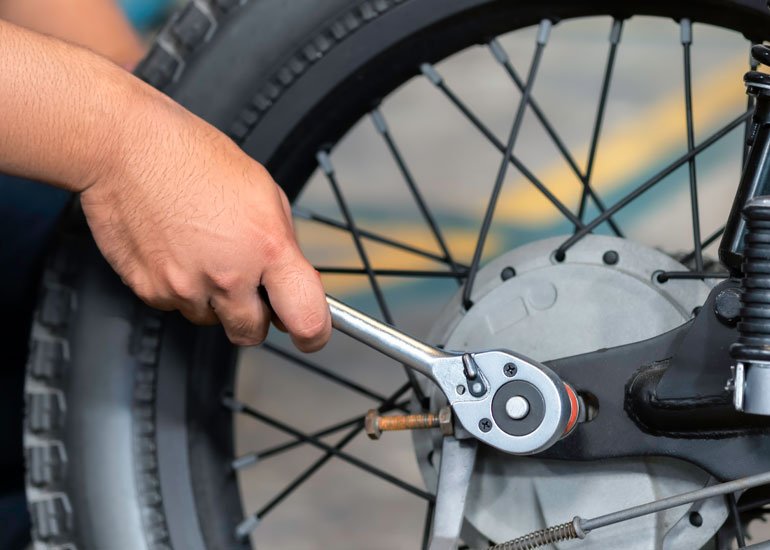
Difference Between Plugging and Patching
Tire Plugging
Plugs are short strips of leather, covered with a rubber compound. Once you force the plug into a nail hole, it fills the hole while the rubber vulcanizes to seal the entire thing.
Plugging is simple to do, and in most cases, it doesn’t require the tire to be removed off the wheel. Still, it might not be so simple to do with the wheel on.
You don’t need much skill or experience for plugging, especially since most repair kits come with detailed instructions.
What are the PROS and CONS?
The ease of use and low cost are probably the two most significant advantages of plugs. On top of that, plugs are quite durable.
As we mentioned, you don’t need any special skills to do this. Plugging is usually the quickest solution as well, which is among the reasons why people opt for it quite often.
However, there’s a drawback that’s quite annoying. More precisely, a plug can fail. In most cases, it happens when a hole is too large for the plug. It can also occur if it’s weirdly shaped, but you shouldn’t use plugs on those punctures anyway.
Tire Patching
A patch is a piece of rubber with an adhesive on its backside. It’s meant to be placed on the inside of the tire, to vulcanize when it heats.
Patching is much stronger and more durable than plugging. This method is often the choice of trained technicians who have the right equipment. The process is somewhat trickier because you have to dismount and remount the tire.
This is more expensive to do, and although it’s safer, it’s not always necessary. Things like small nail holes can easily be plugged so that you don’t have to spend as much money and time on patching.

Knowing When to Replace or Repair It
Knowing when you can repair and when you should replace is critical because some punctures might be too severe (see best tires for motorcycles here). If the damage is within an inch of either sidewall or in the shoulder area, you should probably replace the tire.
These areas are those that flex the most and might work your repair loose. This can cause an unexpected loss of air, which is never good.
Another thing you should keep in mind is that tires that were run at low pressure or even flat are most probably damaged beyond repair. The sidewalls are probably damaged because they usually collapse when you start losing air.
If there’s a soft stripe of wear around the sidewall, you might want to replace it. It’s also quite dangerous to repair or put air pressure into a tire that has rubber dust on the inside. Replace it if you’ve removed it to notice the sidewall is worn out and the structure showing.
Keep in mind that repairing or putting air pressure into a severely damaged tire can be highly dangerous.
Read More:
DIY or Mechanic?
Both patching and plugging is something you can do on your own. You don’t need much skill, but make sure to follow instructions if you don’t have any experience.
In most cases, you should consider visiting a professional mechanic. This shouldn’t cost more than $10-$20, depending on the puncture size.
If you bought the tire from a mechanic or a tire-specific business, you should check if they can fix it for you. In most cases, mechanics and another company will repair it for free if you bought it from them.
Patching or Plugging: How to Do-It-Yourself
While you don’t need much experience for plugging, you do need quite some for patching. For this reason, avoid DIY patching unless you’re sure of what you’re doing.
Plugging is simple and more affordable, but it’s not meant for all punctures. It’s only suitable for holes, such as from a nail. The process is quite simple since you need to locate the hole and insert the plug.
Patching is a bit more complicated, although fairly affordable as well. Here’s what you should do when patching:
- Remove the tire and its valve stem core
- Separate it from the rim
- Clean out the puncture hole using an air grinder
- Remove any dirt and debris near the puncture
- Apply vulcanized cement to the inner part of your tire
- Apply the patch from the inside out
- Seal the patch and put the tire back together
Frequently Asked Questions
Is it safe to put 'fix a flat' in a motorcycle's tire?
“Fix a Flat” isn’t the safest solution, and we wouldn’t recommend it. Using automotive cans of tire repair can cause unsafe riding conditions and make your tire much trickier to repair or replace later on.
Are there repair kits with compressors?
The market is packed with different kits, and some of them include mini compressors. Such a compressor may or may not be enough for your needs since it all depends on the size of the puncture.
Conclusion
Hopefully, you now understand the difference between plugging and patching and know when you can use the two methods. Again, if you’re unsure of your skills, you might want to get a technician to fix the hole for you.
However, keeping a motorcycle tire repair kit at hand can be more beneficial than you think. It could help you continue your trip if you damaged your tire along the way.
A reliable kit can fix different punctures with ease. It should also be durable and easy to carry around and store, but make sure to consider your needs and preferences as well.














